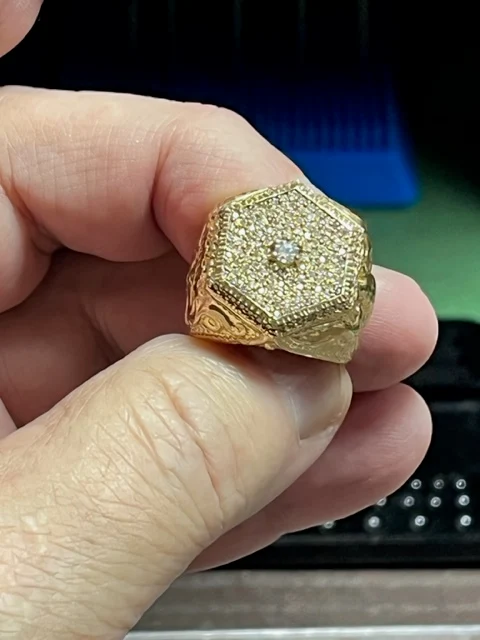"C.A.D." aka "Computer Aided Designing" no mistake about it, this is a fantastic program, it saves much tedium in Diamond Setting. I'm now going to show what takes place from the original computer rendering to the last step in production. Thankfully, I photographed every step while making a pair of large gent's rings. In EACH ring, there are 210 diamonds, plus one larger (0.08 point diamond) in the center. These very small stones measured 0.088 mm. Remembering, that I'm not using any 0.01 diamonds.
These rings were designed to use 160 diamonds on the top of the ring, with another 42 stones around the surrounding area. For your information, all of my Diamond Setting was done WITHOUT any use of an expensive microscope. With this introduction, let's now get started.
With my example of graver cutting, I wanted to show you all the labour in Bright-Cutting. I would be remiss if I avoided the preliminary cutting that takes place.
As an afterthought, I needed to show how 3 "Square stones" are set in this ring. Please observe that I used my Flat-Graver #40 to Bright-Cut the metal. No, I did not use any Triangular file with a #4 cut to clean the inside edge. I used only my finely shaped Flat graver.
I'm now starting to explain the many steps in this Computer Designing process. This is where the diamond setting starts to get easy and with much less labour.
But, all Bright-Cutting MUST BE DONE PRIOR TO ANY GEMSTONE SETTING. WHY now? I need to have full access to Bright-Cutting with my graver.
The next item on my list was to start on these two rings. There were 420 diamonds ready to be set. You can see that there is absolutely no space in or around any of the stones.

My client had little understanding of the complexities and care of the diamond setting, (red flags were starting to show)
Here is another up-close view of the thickness, what do you think I had to do now?
Here are a few of the diamonds that I was going to be working with...just so very small in size. Each stone had only 2 mini claws per stone.
For reference, I used my digital calipers to measure the sizes of the diamonds.
Here are 195 diamonds all laid out.
I marked the little beads with a black marker as I wanted to keep each section of 15+ stones separated. If I avoided the bead markings, I would have "lost my spot" where each stone would be placed.
Every diamond had two beads and every stone had to be Bright-Cut as well.
You can now see how the layout is slowly coming together. I had to make sure that I didn't drop any stones.
I had to make sure that I didn't sneeze.😅
Here is the Rolex watch with all of the 42 stones nicely set and Bright-Cut.
Again, there was no microscope in any of my gemstone setting.
In reviewing these ring tops and disks are the initial computer rendering.
I contacted my CAD designer to assist me in this predicament. Both of us came up with a solution and that was to completely refurbish the watch bezel, ring top, and sides.
From a pitiful initial construction to a pleasing finished metal ring.
Every diamond had two beads and every stone had to be Bright-Cut as well.

Here is another CAD series of disks that had four colours per section. I placed one colour in each disk for easier placement or eventual layout.
At the 4 bars, I used my Flat graver to secure all of the stones along the inside edge. I only ask that prior to any CAD training is that you and everyone learn how to set diamonds. If not, there could be many problems being at your bench.
If you have any questions, kindly contact me at "gerrylewy18(gmail.com".


































.JPG)


No comments:
Post a Comment